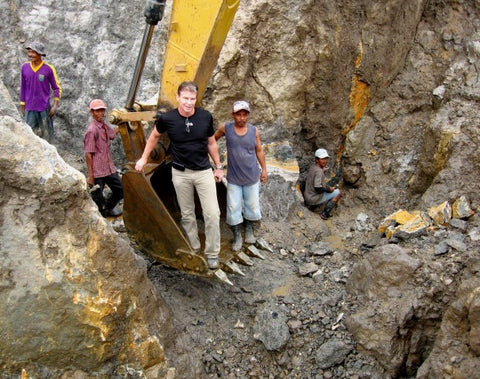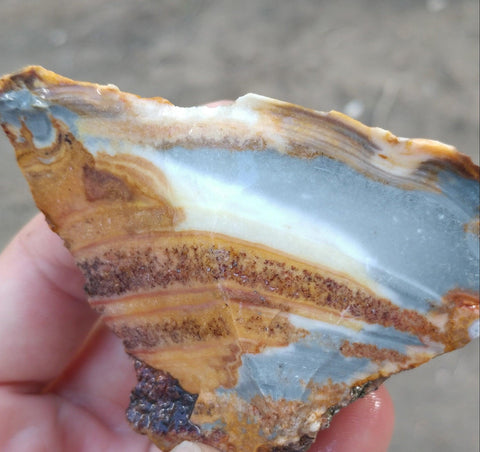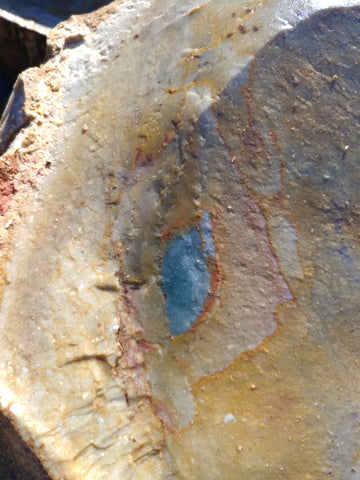Ever wonder what exactly jasper is? Wonder how it forms? I get asked often and the answer is both simple and complex.
The simple answer: Jasper is a opaque silica based material with conchoidal or "shell-like" fracture (like how glass breaks) and a hardness of 7, which cannot be scratched with a steel pocket knife, just like quartz, why? it's got a high quartz content, the crystals in the material are crypto or microcrystalline quartz, so you can't see them but they are there and that is what gives the jasper it's strength.
The complex answer: jasper is NOT a scientific term. When labeling proper jaspers, scientists will label the specimen "cryptocrystalline quartz or microcrystalline quartz: variety jasper".
What we call "jasper" as rockhounds and lapidary artists is most often a stone called a "jasperoid", which I will get into in a minute, but about 20% of things we call "jasper" are just called that by the people who sell them and do not have a high silica content or they are not opaque, both things we use to determine if something is to be called "jasper". Why do people call it a jasper if it is not a jasper? Who knows? Maybe it sounds better? Usually it's a situation where it's a trade name or a regional term for a stone.

"Bumblebee Jasper" from Indonesia is an excellent example of something which is not jasper being called jasper. "Bumblebee Jasper" is a travertine or a calcite based stone formed on the flanks of a volcano, in an active fumerole. Calcite is not nearly as hard as quartz, making "Bumblebee Jasper" a delicate stone which is easily scratched. Not what we think of when we think of durable jasper. When we work with our friends in other countries like Indonesia, often every opaque stone is a jasper to them!

What is this silica of which I speak? Silica is the combination of the elements silicon and oxygen. Silica, being the building blocks of quartz, moves around freely in water and more freely in saline water. It acts like a plastic, looking for places to form globs where ever concentrations occur. What we know about jaspers, since you cannot see visible crystals, is that they were formed in a fairly cool temperature events, as the more heat you introduce, the more sugary the texture becomes as the silica solidifies into quartz.
So what is a jasperoid?
According to the giant scientific paper I just digested, its a stone which takes up free silica from groundwater systems, changing the composition of the stone from its original composition like an ash bed or limestone deposit to a jasperoid.
Not all jasperoids are jaspers though, so what is the difference? Saturation of silica.
Many rocks are like sponges and when silica rich water passes by or through them they suck it up. How much depends on the type of rock and the environment in which it's taking place. Is the environment and fluid hot or cold? How much silica is in the water? What is the PH of the water? PH of the host rock? Is the water saline? All of these things play into how much silica gets drawn into the host rock. Many picture jasper deposits are an excellent example of a stone which starts as an ash or mud which silica saturates and becomes a harder stone where silica was introduced an allowed to form into microcrystalline quartz. Some of the best jasper with highest levels of silica are the muds which form in these hydrothermal systems which can be up to 80-90% silica and almost considered an agate or chalcedony because they approach translucency or you can see light through them.
The jasper in the main picture is a hybrid of the two types of jasper in which we discussed. This jasper formed when a thin layer of vesicular lava flowed over and into silica rich mud and though tiny openings only the finest mud was drawn into and settled in the bubbles creating fine porcelain textured jasper nodules within the cooled bubbles on the flow edges. The material hosting the jasper is an Icelandite (iron rich andesitic basalt) lava which took up the silica it could but for the most part was indurated or already full.
I hope I cleared things up and created curiosity! Please respond with your questions and comments below!



![]()






Melanie Podbielski
Thank you. Very informative post.
Justin
I recently found a lot of jasper in Calgary Alberta.
Took a bit to figure out what it was as they look like large eggs with tree bark on the outside
Gary Brown
Very nice article. I thought Jasper was compressed plant material over millions of years. No?
Leontine
Can Jasper have a shiny appearance when found? Is it possible to find it in gravel? I live in Tucson, AZ.
Great article! Please describe more features such as colors and surface appearance and lots of pictures! Thank you so much!
Sunny Gabriel
Hy there,
Thank you for this explication, I just bought one from a street vedor; it’s unpolished and I was instantly drawn to it.
So, my question is, how are those formed from meteorites? Would it be possible through a supernova?
Mine gives some very interesting vibes, through meditation; I think it was part of a meteorite; the supernova link…